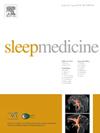Investigating phase coupling of respiratory sinus arrhythmia and slow wave sleep in obstructive sleep apnea patients with and without depression
IF 3.8
2区 医学
Q1 CLINICAL NEUROLOGY
引用次数: 0
Abstract
Phase coherence (λ) between respiratory sinus arrhythmia (RSA) and respiration has emerged as a promising metric for assessing the role of autonomic nervous system (ANS) activity and slow wave sleep (SWS) activities in healthy subjects. This study aims to investigate how λ and SWS activity differ between Obstructive Sleep Apnea (OSA) patients with and without major depressive disorder (MDD) during overnight sleep and explore whether the correlation between λ and SWS activity exists among those OSA patients compared to healthy individuals. Overnight electroencephalogram (EEG), electrocardiograms (ECG), and breathing using plethysmography were recorded from 104 subjects, including 35 healthy individuals (control), 34 OSA subjects with MDD (OSAD+) and 35 OSA subjects without MDD (OSAD+). Slow wave activity was computed by the amplitude envelope of the EEG δ-wave (0.5–4 Hz). The interbeat intervals (RRI) and respiratory movement were derived from ECG. RRI and respiration were resampled at a frequency of 10 Hz, and the band passed filtered within the range of 0.1–0.4 Hz before the Hilbert transform was used to extract instantaneous phases of the RSA and respiration. From the analytical signal of the Hilbert transform, the phase coherence (λ) and amplitude of RSA (ARSA) were quantified. Additionally, the heart rate variability (HRV) features were calculated. Our results showed that overnight λ was significantly greater, while the Low Frequency (LF) and High Frequency (HF) components of the HRV were significantly lower in OSAD+ compared to OSAD-. In addition, overnight δ-wave activity was greater in OSAD- compared to both OSAD+ and control groups. Using auto- and cross-correlation analyses, we found that overnight profiles of λ and δ-wave were correlated only in healthy individuals compared to OSAD+ and OSAD-, indicating that sleep apnea may only have an impact on this cortical-cardiorespiratory correlation rather than depression. Our findings suggest that λ and SWS activity appear to be biomarkers for assessing depression in OSA patients, whereas their correlation pattern may serve as a marker for only OSA. This could enhance diagnostic precision and provide valuable insights into the complex physiological mechanisms underlying the corambid of OSA and MDD.
求助全文
约1分钟内获得全文
求助全文
来源期刊

Sleep medicine
医学-临床神经学
CiteScore
8.40
自引率
6.20%
发文量
1060
审稿时长
49 days
期刊介绍:
Sleep Medicine aims to be a journal no one involved in clinical sleep medicine can do without.
A journal primarily focussing on the human aspects of sleep, integrating the various disciplines that are involved in sleep medicine: neurology, clinical neurophysiology, internal medicine (particularly pulmonology and cardiology), psychology, psychiatry, sleep technology, pediatrics, neurosurgery, otorhinolaryngology, and dentistry.
The journal publishes the following types of articles: Reviews (also intended as a way to bridge the gap between basic sleep research and clinical relevance); Original Research Articles; Full-length articles; Brief communications; Controversies; Case reports; Letters to the Editor; Journal search and commentaries; Book reviews; Meeting announcements; Listing of relevant organisations plus web sites.
 求助内容:
求助内容: 应助结果提醒方式:
应助结果提醒方式:


